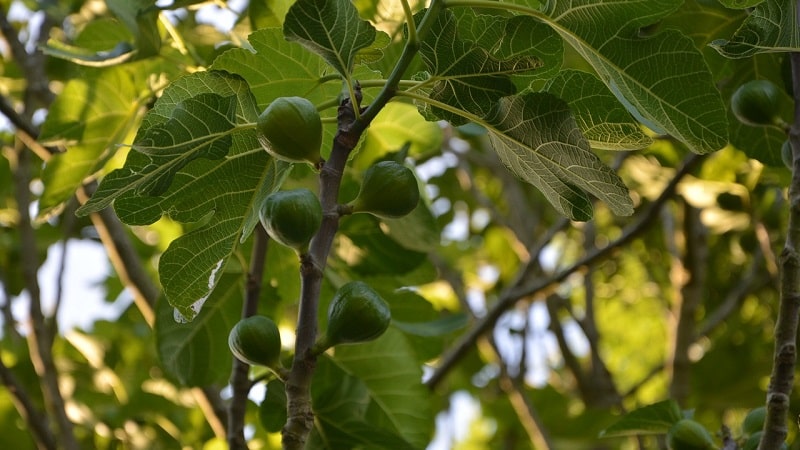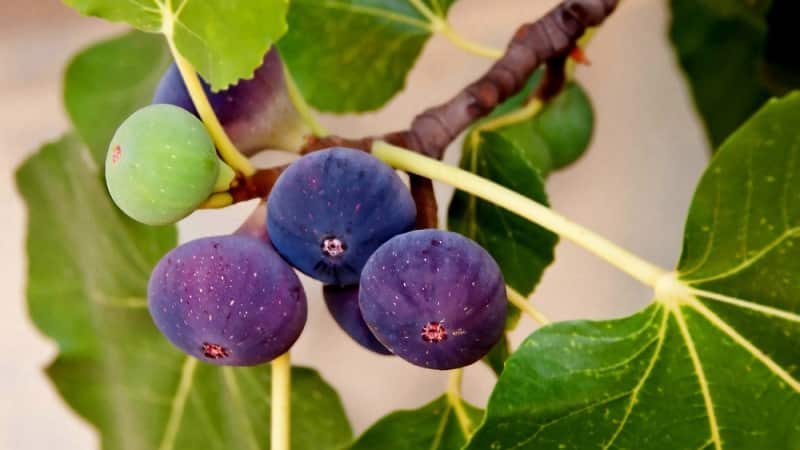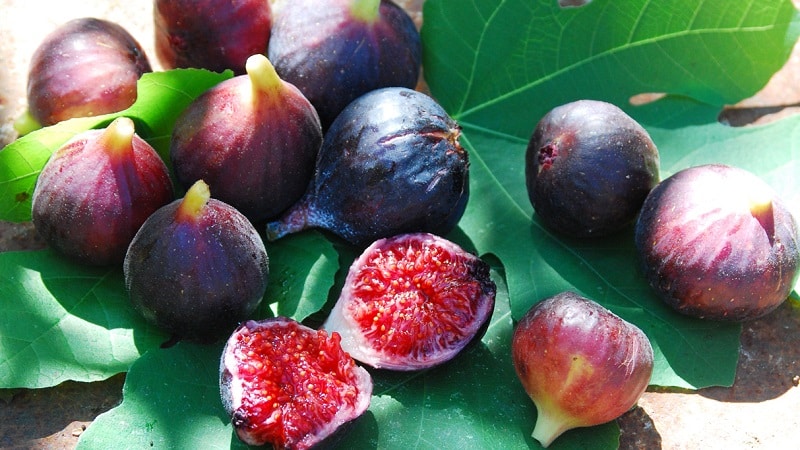What is a fig and what is remarkable about the fig tree?
Fig is a medium-sized tree with a smooth crown and spreading branches, with a unique flowering and fruiting system. The plant is considered one of the oldest fruit crops and is mentioned in the Bible. It was with fig leaves that Adam and Eve covered their nakedness when leaving the paradise of Eden. Figs, figs or figs are the fruits of a female tree with aromatic, sweet flesh and many seeds that crunch in the teeth. We will tell you everything about figs: about the tree, leaves, distribution, flowering, structure and appearance of fruits.
What are figs and fig trees?
Common fig, or fig tree (lat. Ficus carica) is a deciduous tree from the genus Ficus, Mulberry family. It is also called the Carian ficus, since Caria, a mountainous area in Asia Minor, is considered its homeland. The culture is widespread in the Carpathians, Mediterranean countries, Central Asia, the Caucasus, the Crimean Peninsula, the Black Sea coast - there the trees are cultivated as a valuable fruit crop. In our latitudes the plant is grown as a bush.
Figs are the oldest crop that was grown in Arabia, Phenicia, Syria and Egypt. In the 13th century, the fig tree was cultivated as a valuable crop in the kingdom of Pylos. The plant appeared in North and South America at the end of the 16th century.

Still, are figs a fruit or a berry? According to the botanical description - neither one nor the other. Technically, the edible part of the fig is the ripe flower, so it is correctly called the fruit. Figs are also called “wineberry” or “fig” fruit, hence the confusion. Other names are fig, fig tree, Smyrna berry.
Figs are mentioned in the Bible and Koran. The main book of Muslims describes how the first man, tempted by a woman, ate the fruit of the fig tree. The Bible tells how the first people, expelled from Eden, shyly covered themselves with fig leaves. The expression “fig leaf” has acquired several meanings over time: an unsuccessful concealment of shortcomings and a meaningless, meaningless document.
Interesting! In ancient Greece, the fruit of the fig tree was considered a phallic symbol. The famous fico gesture (thumb sandwiched between the middle and index fingers) was used in the Middle Ages against the evil eye and was at the same time considered obscene.
Botanical description of the plant
Fig tree - what is it from a botanical point of view? This medium-sized tree 10-15 m high from the genus Ficus with smooth gray bark. The lifespan of the plant is 30-300 years. The roots of the tree are able to penetrate deep into even the densest rock soil and take root on mountain slopes. In favorable conditions, the branches form a beautiful spreading crown with dense foliage.
Fig leaf - large, alternate, 3-5-7 palmate-lobed or separate with deciduous stipules. The structure is rigid. The fig tree sheds its leaves at the beginning of winter, and new buds bloom in early April.
Interesting things on the site:
Short generative shoots form in the axils of fig leaves, producing two types of inflorescences - figs and caprifigs. Fig flowers, invisible to the eye, develop inside these shoots.

Figs grow into spherical or oval formations. At the top there is a hole with an internal cavity. It contains small flowers of different sexes. Caprifigi - small inflorescences - contain male flowers.
Fig fruits, with the exception of hybrid parthenocarpics, have a unique type of pollination. The plant forms 3 types of inflorescences. In one, the eggs and larvae of tiny black blastophagous wasps develop. Insects perform the responsible job of transferring pollen from the male tree to the female tree.
Sami blastophages without figs are not able to reproduce. In the spring, the female is fertilized by a wingless male inside the male inflorescence, after which she crawls out through the upper opening and collects pollen from the male flower with her body. The female then looks for where to lay her eggs and tries to colonize the second type of inflorescence that bears fruit. However, their structure does not allow females to lay eggs in them. While the wasp is looking for a new home, it manages to pollinate female flowers and lays eggs in the third type of inflorescence. At the beginning of autumn, a new generation of females appears and lays eggs in the flower house. In spring the cycle repeats. The process of pollination is called caprification.
Interesting! Paleontological data indicate that this system developed 34 million years ago.
Fruiting occurs 2-3 years after planting. The plant's development cycle is slow, fruiting lasts about 9 months.
Pear-shaped, sweet and juicy fruits with small seeds inside are formed from female inflorescences. When chewed, they crunch on the teeth like sand. The figs are covered with a thin skin with slight pubescence. The top has a peephole - a hole covered with scales.The color of the fruit depends on the variety and can be yellow, dark blue, purple, black-blue and yellow-green.
What is a fig? The cut reveals red pulp with many seeds. The aroma is rich, sweet and pleasant. The taste is sweet, not cloying, unique, a little watery. Dried figs are even sweeter and more aromatic.
Read also:
Benefits and harms of grape juice, preparation and use
The best ways to store lemons at home
How to determine the degree of ripeness of a mango and ripen the fruit
Features of fruiting fig tree
Fruiting of a fig tree is impossible without caprification - a unique pollination system. Carl Linnaeus himself puzzled over the mystery of the appearance of fruits for a long time, but was never able to solve it completely. However, the process of fruit appearance was figured out by the ancient Greeks. They collected caprifages and hung them on trees with female inflorescences, like garlands on a Christmas tree. The Greeks learned to preserve them at low temperatures and traded them.

Fruiting of fig trees is divided into three cycles:
- In April Before the leaves appear, small young fruits are formed. They are called “early figs” - a symbol of the end of winter. They are not particularly juicy, but are suitable for eating.
- At the end of May Juicy and unusually tasty figs with a short shelf life ripen on deciduous trees.
- In August Late figs are ripening, suitable for fresh consumption, making jam and dried fruit.
Conclusion
Figs are a deciduous plant native to the tropics that produce healthy, juicy and aromatic fruits. The skin color varies from yellow-green to black-blue depending on the variety.Pear-shaped fruits, called figs, figs, and figs, ripen exclusively on female trees. The pollination process is impossible without blastophagous wasps that breed on male trees. It is these insects that carry pollen on their bodies.